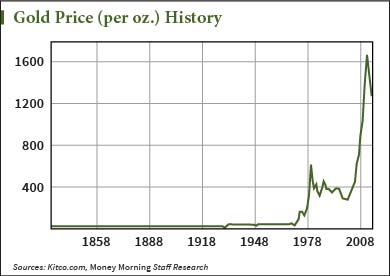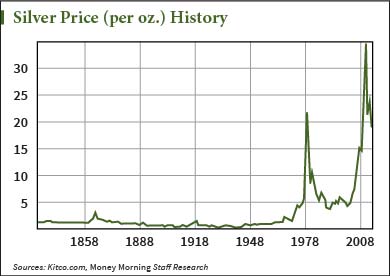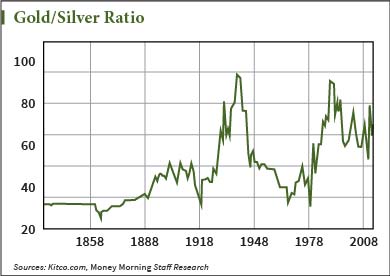The gold/silver ratio is yet another indication that silver is grossly underpriced.
Simply put, the gold/silver ratio is the price of gold divided by the price of silver.
 It is the "oldest continuously observed exchange rate in the world," according to Shayne McGuire, an emerging markets equities and gold fund manager for Teacher Retirement System of Texas and author of The Silver Bull Market: Investing in the Other Gold.
It is the "oldest continuously observed exchange rate in the world," according to Shayne McGuire, an emerging markets equities and gold fund manager for Teacher Retirement System of Texas and author of The Silver Bull Market: Investing in the Other Gold.
McGuire also points out in his book that the gold/silver ratio is historically out of balance. For thousands of years the ratio of gold's value to silver's value was about 14 to 1.
And from 1833 to 1876, that ratio was below 16-to-1. This was before it took off, never to return to those levels again until 1979. And even that was a special case, when the Hunt family famously cornered the market and manipulated prices up.
 Charts of the gold price history and silver price history show just how much this ratio has changed.
Charts of the gold price history and silver price history show just how much this ratio has changed.
Coming into the 20th century, the steady gold/silver ratio started to become more volatile. It strayed far from the 14-to-1 historical standard. It was as high at 98-to-1 in 1939. It hasn't hit that peak since.
But it's still unjustifiably high.
By 2014 average prices, the gold/silver ratio was 66-to-1. That number has only climbed in 2015. As of yesterday's closing spot gold price and spot silver price, the ratio was about 72-to-1.
 "Odds are it's topping out, or about to do so soon. That means the gold/silver ratio will likely revert to its longer-term average and start trending back down," Money Morning Resource Specialist Peter Krauth said.
"Odds are it's topping out, or about to do so soon. That means the gold/silver ratio will likely revert to its longer-term average and start trending back down," Money Morning Resource Specialist Peter Krauth said.
It's not just that the gold/silver ratio is more than five times its historical average that indicates silver is underpriced.
It's also its scarcity in relation to gold.
Here's what that says about the price of silver today...
What the Gold/Silver Ratio Shows Us About Silver's Value
According to Goldcorp Inc. (NYSE: GG), there is one gram of silver for every 12.5 metric tons of earth.
And there's one gram of gold for every 250 metric tons.
Just by those measures, the true ratio of gold prices to silver prices should be 20-to-1.
That means that at yesterday's spot closing price of $1,214 an ounce, silver prices should be at $60.70 an ounce to align with that ratio. That's 264% above the current price of silver at $16.965 an ounce.
This points to a frustrating reality about silver prices...
Silver is just not getting the respect it deserves as an industrial and precious metal. The current silver price doesn't reflect its versatility.
Certainly, silver has its value as an investment. Much like gold it can hedge against falling equity markets because precious metals don't always move in the same direction as stocks.
While silver is a lot more volatile and requires a smaller portfolio holding than its much steadier sister metal, both gold and silver as investments can be powerful tools to minimize losses when equity markets sink.
But silver is often viewed too narrowly. It is the "poor man's gold." It moves with gold prices, but will either see a much more pronounced surge when gold prices tick up or a steeper decline when gold prices fall.
[epom key="ddec3ef33420ef7c9964a4695c349764" redirect="" sourceid="" imported="false"]
It's an alternative investment vehicle that sees residual investment interest when traders pour into gold. But it is much more thinly traded, so price swings are much more dramatic.
"The silver market is tiny compared to the gold market," Richard Checkan, president and chief operating officer of Asset Strategies International told Money Morning. "It's like throwing a rock into a lake versus a puddle; the relative splash is much bigger in the puddle."
Silver is much more than gold's sidekick.
Silver garners a lot of demand from outside Wall Street. Of the 1.1 billion ounces of global demand in 2013, 245.6 came from silver bullion and coins, according to Thomson Reuters GFMS's 2014 Silver Survey.
But, most of the physical demand - 586.6 million ounces - came from industrial users. Of that 233.9 million ounces was used for electronics, 62.4 million ounces was for brazing alloys and solders, and 50.4 million was for photovoltaic uses.
Silver demand outstripped supply by 103 million ounces in 2013. This was the third year in a row where demand eclipsed supply.
And silver will play an important role in an emerging trend - so-called "smart clothes."
"Sports and technology companies have already developed wristbands, shoe inserts, and smartphone apps that can track your heart rate, distance covered, and several other data points," Money Morning's Krauth said. And "silver is clearly an integral part" of this burgeoning industry.
"Silver fibers track distance, calories burned, intensity of movement, heart rate, stress rate, breathing, and a host of other biometric data," Krauth added.
It's not just the gold/silver ratio that suggests silver prices are unreasonably low. It's also its value as an industrial metal that suggests the white metal has a way to climb.
Avoid this gold scam and make sure you own the real deal – this video has seven steps to test your physical gold today:
Silver Price Forecast 2015: Money Morning Resource Specialist Peter Krauth sees 2015 as a good year for silver. To find out just how far he sees the white metal heading, check out his 2015 forecast...


